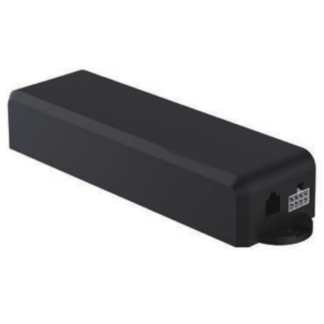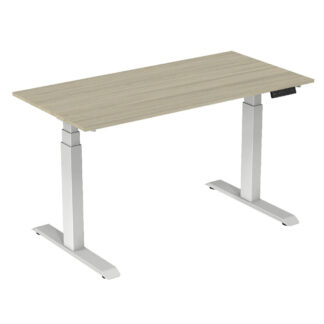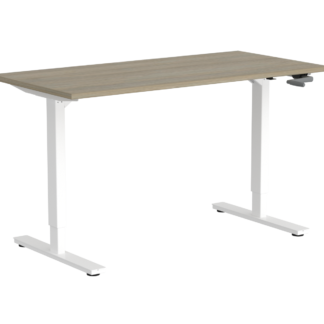Deciding between a 2 stage or a 3 stage adjustable height desk depends on your specific needs, preferences, and budget. Here are some factors to consider when making your decision:
- Height Range: Determine the range of height adjustment you require. If you’re of average height (Below 5.10 feet) and the standard height range of a 2-stage desk meets your needs for both sitting and standing positions, it may suffice. However, if you’re particularly tall (above 5.10 feet) and need a broader range of height adjustment, a 3-stage desk could be more suitable.
- Stability: Consider the stability of the desk, especially when extended to its maximum height. Generally, 3-stage desks offer enhanced stability due to the additional support provided by the extra stage. If stability is a priority for you, especially if you plan to use heavier equipment or accessories on your desk, a 3-stage desk might be preferable.
- Versatility: Think about how you plan to use the desk. If you anticipate needing flexibility in your sitting and standing positions, a 3-stage desk’s broader height range can accommodate a wider range of preferences. This versatility is beneficial if multiple users will be using the desk or if your preferences change over time.
- Budget: Compare the prices of 2-stage and 3-stage desks. Generally, 3-stage desks may be slightly more expensive due to the additional components and complexity of the lifting mechanism. Consider your budget and whether the extra features and benefits of a 3-stage desk justify the higher cost for your needs.
- Quality: Assess the quality and reputation of the manufacturer or brand. Look for desks with high-quality materials, sturdy construction, reliable lifting mechanisms, and good customer reviews. A well-built desk, regardless of the number of stages, will provide durability and long-term satisfaction.
Ultimately, the best choice between a 2-stage and a 3-stage standing adjustable height table depends on your individual requirements and priorities. Evaluate your height needs, stability concerns, versatility requirements, budget constraints, and the quality of available options to make an informed decision that suits your preferences and lifestyle.
A 3-stage or 3-segment height adjustable sit stand desk refers to a type of standing desk that features three telescoping segments or stages within each leg of the desk’s lifting mechanism. This design allows for a greater range of height adjustment compared to desks with fewer stages.
Here’s what you need to know about 3-stage height adjustable sit-stand desks:
- Increased Height Range: The additional stage in each leg provides the desk with a broader range of height adjustment. This means that users can typically lower the desk to a lower seated position or raise it to a higher standing position compared to desks with fewer stages.
- Enhanced Stability: With three stages, the desk’s lifting mechanism can offer increased stability and weight capacity, especially when the desk is extended to its highest position. The additional support provided by the extra stage helps distribute the weight more evenly and reduces the risk of wobbling or instability.
- Versatility: The extended height range makes 3-stage sit-stand desks suitable for a wider range of users, including taller individuals who may require a higher standing position or shorter individuals who prefer a lower seated position. This versatility makes them suitable for various work environments and user preferences.
- Smooth Adjustment: While the number of stages doesn’t necessarily dictate the smoothness of height adjustment (which also depends on the quality of the lifting mechanism), 3-stage desks can offer smooth and consistent height adjustments, particularly when equipped with high-quality motors and components.
Overall, 3-stage height adjustable sit-stand desks are designed to provide users with increased flexibility, stability, and comfort by offering a wider range of height adjustment options compared to desks with fewer stages. These desks are suitable for individuals who value versatility and require a desk that can accommodate various sitting and standing positions.
In the context of height adjustable standing table or desks, the terms “2-stage” and “dual-stage” refer to the construction of the desk’s lifting mechanism, specifically how many segments or stages the desk’s legs have for adjusting height. Let’s break down what each term means:
- 2-Stage Height Adjustable Standing Table:
- A 2-stage height adjustable standing table has two telescoping segments or stages within each leg.
- These desks typically offer a range of height adjustment that is sufficient for most users, allowing them to transition between sitting and standing positions comfortably.
- The height adjustment range of a 2-stage desk may vary depending on the specific model and manufacturer, but it generally covers a range suitable for most individuals.
- Dual-Stage Height Adjustable Standing Table:
- “Dual-stage” is essentially another term for a 2-stage height adjustable standing table.
- The use of “dual” in this context emphasizes the presence of two stages or segments within each leg of the desk.
- Like the 2-stage desks, dual-stage desks provide height adjustability through two segments in each leg, allowing users to set their preferred sitting or standing height.
In summary, both “2-stage” and “dual-stage” refer to the same type of height adjustable standing table, which features two telescoping segments or stages in each leg for adjusting the desk’s height. These desks offer versatility in accommodating different user heights and preferences for sitting or standing positions.
There are several types of sit stand height adjustable table available on the market, each offering different mechanisms for adjusting height and various features to suit different needs and preferences. Here are some common types:
- Manual Height Adjustable Standing Desk: These desks typically feature a hand-operated crank mechanism or lever that allows users to manually adjust the desk’s height. Users turn the crank or lift the lever to raise or lower the desk to their desired height.
- Electric Height Adjustable Desk: Electric standing desks are equipped with electric motors that raise and lower the desk’s height with the push of a button. These desks usually offer smooth and effortless adjustment and may come with additional features like programmable height presets for easy customization.
- Pneumatic Height Adjustable Desk: Pneumatic standing desks utilize air pressure to raise and lower the desk’s height. Users can adjust the desk by pressing a lever or button, which activates the pneumatic mechanism to move the desk up or down.
- Converter or Riser Desks: These are units that can be placed on top of an existing desk or workspace to convert it into a height adjustable desk. Converter desks typically feature a platform for the monitor, keyboard, and mouse, which can be raised or lowered to accommodate sitting or standing positions.
- Crank Adjustable Desks: Crank adjustable desks operate similarly to manual height adjustable desks but use a crank handle instead of a lever. Users rotate the crank handle to adjust the desk’s height to their desired level.
- Lifting Column Desks: These desks use lifting columns, which are telescopic columns that expand and contract to adjust the desk’s height. Lifting column desks may come in electric or manual versions and offer smooth and stable height adjustment.
- Hydraulic Height Adjustable Desk: Hydraulic standing desks use hydraulic cylinders to raise and lower the desk’s height. Users can adjust the desk by pressing a button or lever, which activates the hydraulic mechanism to move the desk up or down.
Each type of height adjustable desk has its advantages and may be suitable for different environments and user preferences. When choosing a height adjustable desk, it’s essential to consider factors such as ease of adjustment, stability, weight capacity, and additional features that may enhance usability and comfort.
The main difference between an electric single motor desk and an electric dual motor standing height adjustable desk lies in the number of motors used to adjust the desk’s height and how it affects performance and stability. Here’s a breakdown of each:
- Electric Single Motor Desk:
- Single motor desks are equipped with one motor that drives the height adjustment mechanism.
- The motor is usually located in the center of the desk’s frame.
- Single motor desks tend to be more budget-friendly compared to dual motor desks.
- While single motor desks can provide adequate height adjustment, they may have limitations in terms of weight capacity and stability, especially at higher heights or when supporting heavier loads.
- Single motor desks might experience slightly more lateral movement or wobble when adjusting the height, particularly when fully extended.
- Electric Dual Motor Height Adjustable Standing Desk:
- Dual motor desks feature two motors, one on each leg or column of the desk.
- Having two motors provides more balanced and synchronized lifting, resulting in smoother and more stable height adjustments.
- Dual motor desks are generally more robust and offer higher weight capacities compared to single motor desks.
- The use of two motors distributes the workload more evenly, reducing the strain on individual components and potentially increasing the desk’s longevity.
- Dual motor desks are often preferred for heavier workloads or environments where stability and smooth operation are crucial, such as in professional office settings or for users who frequently adjust their desk height throughout the day.
In summary, while both electric single motor desks and electric dual motor desks offer height adjustability, dual motor desks tend to provide superior stability, smoother operation, and higher weight capacity, albeit at a potentially higher cost. The choice between the two depends on individual preferences, budget, and intended use.
The primary difference between a manual desk and an electric single motor desk lies in the mechanism used to adjust the desk’s height.
- Manual Desk:
- Mechanism: Manual desks typically feature a hand-operated crank mechanism or lever that allows users to manually adjust the desk’s height.
- Operation: Users turn the crank handle or lift the lever to raise or lower the desk to their desired height.
- Effort: Adjusting the height of a manual desk requires physical effort from the user, as they need to rotate the crank or lift the lever.
- Speed: The adjustment speed of manual desks depends on the user’s speed in turning the crank or lifting the lever. It may take longer compared to electric desks.
- Cost: Manual desks are often less expensive than electric desks due to their simpler mechanism.
- Electric Single Motor Desk:
- Mechanism: Electric single motor desks are equipped with an electric motor that raises and lowers the desk’s height.
- Operation: Users can adjust the desk’s height with the push of a button. The electric motor drives the height adjustment mechanism.
- Effort: Electric desks require minimal physical effort from the user, as the motor handles the height adjustment process.
- Speed: Electric desks offer quicker and smoother height adjustment compared to manual desks. They can typically adjust to different heights faster.
- Cost: Electric single motor desks are usually more expensive than manual desks due to the inclusion of an electric motor and associated components.
In summary, while both manual desks and electric single motor desks offer height adjustability, the key differences lie in the method of adjustment, effort required from the user, speed of adjustment, and cost. Manual desks require manual effort from the user to adjust height, while electric desks offer effortless adjustment at the push of a button, albeit at a higher cost.




